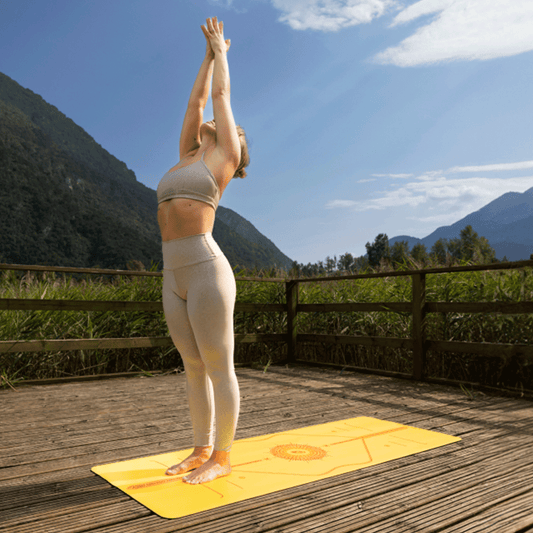Wheels and Wild Things may catch more air, but we’re big fans of the basic Bridge. A little Setu Bandhasana counters the affects of long hours spent sitting and slouching, making it a valuable part of a home asana practice for yoga beginners. Bridge also has a lot of benefits for more experienced yogis, even if they can do deeper backbends. After years of forward bending and hip opening, some yogis develop pain in their SI joints, which can be due to over stretching the ligaments around the sacrum so that they inadequately support the joint. Strengthening the overlying support muscles in poses like Bridge can help. We’ll take you through a safe set up and offer One-Legged and Supported variations.
Benefits of Bridge Pose
- Improves spinal mobility
- Opens the chest
- Stretches the shoulders and neck
- Strengthens the thighs, glutes, pelvic supports, and back muscles
Instructions
- Come to lie on your back with your knees bent toward the ceiling and the soles of your feet flat on the mat hips-width apart and parallel to each other.
- Reach down with your fingertips and make sure you can skim your heels. This should set up your posture so that when you press your hips up, your knees are over your ankles.
- Press into the soles of your feet and firm your glutes to lift your pelvis away from the floor. You can do this on an inhalation of breath to get the benefit of lifting or on an exhalation for more power. Experiment with both and see which one you prefer.
- Tuck your shoulders under one at a time to lift your chest. Interlace your fingers behind your back, hold onto the edges of your mat, or bring your palms face down or face up on the mat.
- Keep your knees over your ankles. Imagine holding a block between your knees (or take a block between them before you press up) to keep the knees from splaying out. Continue to lift your pelvis toward the ceiling.
- Keep your gaze toward the ceiling and your head and neck stationery.
- Stay in the posture for several cycles of breath. When you a ready to come down, release your hands if they are interlaced and lower your hips back to the floor on an exhalation.
One-Legged Bridge
Go through steps 1-6, above.
Transfer your weight to the right leg while keeping your hips in a neutral position.
Lift your left foot away from the floor and draw your left knee toward your chest.
Straighten your left leg toward the ceiling.
After several breaths, rebend your left knee and lower your left foot parallel to your right foot. Then repeat the posture with the right leg lifted.
Lower your hips to the mat.

Supported Bridge
Supported Bridge is a restorative staple and a lovely way to get a gentle backbend and heart opener in your practice. Have a yoga block nearby as you set up for this posture.
Go through steps 1-3 as described above.
Once your hips are lifted, slide a yoga block under your hips. You can use the block on any of its three possible heights, although the highest option is not as stable as the lower two. Lower your hips until your sacrum rests on the block.
You can tuck your shoulders under for a more heart-opening experience, but you don’t need to interlace your fingers if the block is in the way. Let your palms turn up to face the ceiling.
Enjoy this passive stretch for several breaths before pressing into your feet to lift your hips, removing the block, and then lowering slowly to the floor.





































